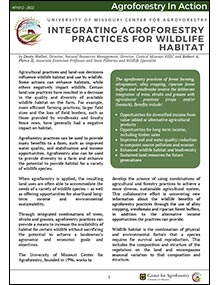Editor's note
This page currently contains only the introductory section of this guide. For the entire text, please download the PDF.
Agricultural practices and land-use decisions influence wildlife habitat and use by wildlife. Some actions can enhance habitats, while others negatively impact wildlife. Certain land-use practices have resulted in a decrease in the quality and diversity of available wildlife habitat on the farm. For example, more efficient farming practices, larger field sizes and the loss of field borders, such as those provided by windbreaks and brushy fence rows, have generally had a negative impact on habitat.
Agroforestry practices can be used to provide many benefits to a farm, such as improved water quality, soil stabilization and income opportunities. Agroforestry also can be used to provide diversity to a farm and enhance the potential to provide habitat for a variety of wildlife species.
When agroforestry is applied, the resulting land uses are often able to accommodate the needs of a variety of wildlife species – as well as offering opportunities for shorthand long-term income and environmental sustainability.
Through integrated combinations of trees, shrubs and grasses, agroforestry practices can provide a means to increase the availability of habitat for certain wildlife without sacrificing the potential to achieve a landowner’s agronomic and economic goals and objectives.
The University of Missouri Center for Agroforestry, founded in 1996, works to develop the science of using combinations of agricultural and forestry practices to achieve a more diverse, sustainable agricultural system. This collaborative effort is uncovering new information about the wildlife benefits of agroforestry practices through the use of alley cropping, windbreaks and riparian forest buffers, in addition to the alternative income opportunities the practices can provide.
Wildlife habitat is the combination of physical and environmental factors that a species requires for survival and reproduction. This includes the composition and structure of the vegetation on the land and encompasses seasonal variation to that composition and structure.
Whether designing land-use goals with wildlife, short/long-term income or stewardship objectives in mind, consider the various components that define wildlife habitat:
- Food
- Cover
- Water
- Space
Once knowledge of the life history, biology and habitat requirements of the species are known, you can begin to identify the limiting factors that might exist on your property and conduct management practices that provide the needed resources. To be successful, develop a plan of action (a wildlife management plan) and begin to integrate wildlife considerations (such as habitat management techniques) along with your other ongoing land management objectives. Having a plan to work from will help ensure success. Often, many of the habitat improvement practices that are discussed will be beneficial for a diversity of wildlife species.
This guide provides a general overview on managing habitats for the following wildlife species of interest to many private landowners:
- White-tailed deer
- Eastern wild turkey
- Bobwhite quail
- Waterfowl
- Mourning doves
In addition, specific plants that can be used to provide food and cover are identified, as well as suggestions on how to integrate management practices that benefit the desired species. Information is also provided on methods that can be used to reduce management costs and the potential income opportunities that can result.
Topics
- White-tailed deer
- Eastern wild turkey
- Bobwhite quail
- Waterfowl
- Mourning dove
- Habitat needs
- Management guidelines
- Agroforestry practices
Pages
- 24
